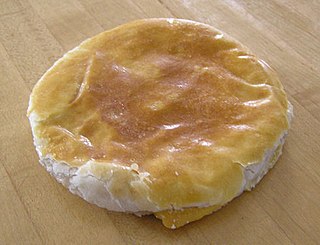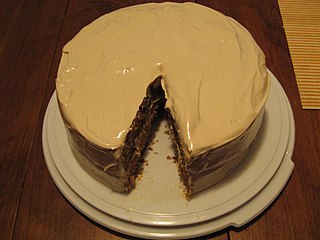
A biscuit, in most English speaking countries, is a flour-based baked and shaped food item. Biscuits are typically hard, flat, and unleavened. They are usually sweet and may be made with sugar, chocolate, icing, jam, ginger, or cinnamon. They can also be savoury, similar to crackers. Types of biscuit include sandwich biscuits, digestive biscuits, ginger biscuits, shortbread biscuits, chocolate chip cookies, chocolate-coated marshmallow treats, Anzac biscuits, biscotti, and speculaas.

Shortbread or shortie is a traditional Scottish biscuit usually made from one part white sugar, two parts butter, and three to four parts plain wheat flour. Shortbread does not contain any leavening, such as baking powder or baking soda. Shortbread is widely associated with Christmas and Hogmanay festivities in Scotland, and some Scottish brands are exported around the world.

A sweetheart cake or wife cake or marriage pie is a traditional Chinese cake with a thin crust of flaky pastry, made with a filling of winter melon, almond paste, and sesame, and spiced with five spice powder. "Wife cake" is the translation of 老婆饼 from Chinese, and although the meaning is "wife", the literal translation is "old lady cake", paralleling the colloquial usage of "old lady" for "wife" in English. In Hong Kong, it is known as a specialty of the Yuen Long District.

Gingerbread refers to a broad category of baked goods, typically flavored with ginger, cloves, nutmeg, and cinnamon and sweetened with honey, sugar, or molasses. Gingerbread foods vary, ranging from a moist loaf cake to forms nearly as crisp as a ginger snap.

Rice pudding is a dish made from rice mixed with water or milk and commonly other ingredients such as sweeteners, spices, flavourings and sometimes eggs.

Ratafia is a broad term used for two types of sweet alcoholic beverages, a flavouring essence whose taste resembles bitter almonds, later to a ratafia flavoured biscuit, a biscuit to be eaten along with ratafia, and later still, to a cherry variety.

Pennsylvania Dutch cuisine is the typical and traditional fare of the Pennsylvania Dutch. According to one writer, "If you had to make a short list of regions in the United States where regional food is actually consumed on a daily basis, the land of the Pennsylvania Dutch—in and around Lancaster County, Pennsylvania—would be at or near the top of that list," mainly because the area is a cultural enclave of Pennsylvania Dutch culture.

Spice cake is a type of cake that is traditionally flavored with a mixture of spices. The cake can be prepared in many varieties. Predominant flavorings include spices such as cinnamon, cloves, allspice, ginger, and nutmeg.

Christmas cookies or Christmas biscuits are traditionally sugar cookies or biscuits cut into various shapes related to Christmas.

A gingersnap, ginger snap, ginger nut, or ginger biscuit is a biscuit flavored with ginger. Ginger snaps are flavored with powdered ginger and a variety of other spices, most commonly cinnamon, molasses and clove. There are many recipes. The brittle ginger nut style is a commercial version of the traditional fairings once made for market fairs now represented only by the Cornish fairing.

The Basler Läckerli is a traditional hard spice biscuit originating from Basel, Switzerland. It is made of honey, hazelnuts, almonds, candied peel, and Kirsch. After baking in a thin layer, the still hot dough is topped with a sugar glaze and cut into rectangular pieces.
There are many geographically indicated foods of the United Kingdom. In British cuisine, there is a custom of naming foodstuffs with reference to their place of origin. However, there are other reasons for this practice; Scotch egg, which was invented in London and Dover sole which indicates where they were landed, for example.

Jumbles are simple butter cookies made with a basic recipe of flour, sugar, eggs, and butter. They can be flavored with vanilla, anise, or caraway seed used for flavoring, or other flavoring can be used like almond. They were formerly often made in the form of rings or rolls.

Cornish cuisine encompasses the cooking styles, traditions and recipes associated with Cornwall and the Cornish people. It has been heavily influenced by the geography of the county as well as its social history.

Semolina pudding or semolina porridge is a porridge-type pudding made from semolina, which is cooked with milk, or a mixture of milk and water, or just water. It is often served with sugar, cocoa powder, cinnamon, raisins, fruit, or syrup. It is similar to grain based halva or halawa. A similar consistency to rice pudding can also be made by using more semolina and by baking, rather than boiling.

Confections of the English Renaissance span a wide range of products. All were heavily based on sugar, which was a relatively new development. Many were considered to have medicinal properties – a belief that was influenced by the Arabic use of sugar as a medicine and that carried over from medieval sugar usage. In the mid-sixteenth century, sugar became cheaper and more widely available to the general populace due to European colonization of the New World. It began to be used more as a flavouring, preservative, and sweetener, as it is today, rather than as medicine.
















